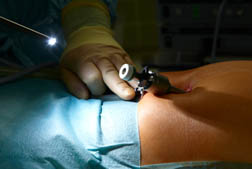 Then again, the FDA stopped short of issuing a recall of the power morcellation devices, even after one manufacturer voluntarily withdrew its powered equipment for Laparoscopic Uterine surgery from the market. Specifically, Johnson & Johnson issued letters to health care providers two years ago this July, suggesting that “the risk-benefit assessment associated with the use of these devices in hysterectomy and myomectomy procedures for removing fibroids remains uncertain.”
Then again, the FDA stopped short of issuing a recall of the power morcellation devices, even after one manufacturer voluntarily withdrew its powered equipment for Laparoscopic Uterine surgery from the market. Specifically, Johnson & Johnson issued letters to health care providers two years ago this July, suggesting that “the risk-benefit assessment associated with the use of these devices in hysterectomy and myomectomy procedures for removing fibroids remains uncertain.”The FDA holds the same position. It warned that Laparoscopic Uterine surgery for hysterectomy and myomectomy for fibroid removal puts the patient at risk for the spread of a uterine sarcoma - an undetected form of cancer amidst a collection of benign fibroids. Laparoscopic Uterine surgery has been seen as spreading an otherwise undetected sarcoma to other parts of the abdomen, reducing a patient’s chance of survival.
Various ovarian cancer lawsuits allege just that. One such lawsuit filed by plaintiffs Janet and Randy Gager allege in a lawsuit filed in California Superior Court in April of this year that Laparoscopic Uterine surgery performed while using equipment manufactured by Karl Storz Endoscopy America Inc. fostered a spread of cancer throughout Janet Gager’s abdomen.
According to the Laparoscopic Uterine surgery lawsuit, Gager underwent a procedure for removal of benign fibroids. The equipment used during the Laparoscopic procedure proceeded to dissect the fibroids, after which they would be removed through the minimally invasive procedure. However, according to court records, the uterine fibroid turned out to be a leiomyosarcoma. In the process of busting up the fibroid via the Laparoscopic procedure, cancer cells from the leiomyosarcoma were spread throughout the plaintiff’s abdomen, or so it has been alleged.
Several other Laparoscopic Uterine surgery lawsuits allege similar complaints.
When the issue first bubbled up to the surface a few years ago, many hospitals stopped using the powered Laparoscopic equipment altogether. Others refused to perform any kind of Laparoscopic Uterine Surgery for women without first using a containment device that would prevent the spread of potentially cancerous fibroids.
Such a containment solution appears to be what the FDA stamped as “approved,” as outlined by Heidi Turner in her article on the so-called PneumoLiner, designed to contain uterine tissue during Laparoscopic Uterine surgery using powered devices.
The approval, the FDA said, is in no way an endorsement or a claim that the PneumoLiner is effective in reducing the risk for spreading cancer.
“We are continuing to warn against the use of power morcellators for the vast majority of women undergoing removal of the uterus, or uterine fibroids.
READ MORE LAPAROSCOPIC POWER MORCELLATION LEGAL NEWS
Thus, the FDA has approved a device that has not been proven to work in the important area of preventing cancer from spreading from power morcellators in the vast majority of cases.
The FDA has identified that one out of 350 women undergoing a hysterectomy or fibroid removal through Laparoscopic Uterine surgery will likely have an undetected uterine sarcoma.
And yet, there has been no mass ban of morcellation devices used in Laparoscopy.
The Laparoscopic Uterine surgery lawsuit is Gager et al v. Karl Storz Endoscopy America, Inc., Karl Storz Endovision, Inc., Karl Storz GMBH & CO., Case No. BC617217, filed April 15, 2016 in the Superior Court of California.
